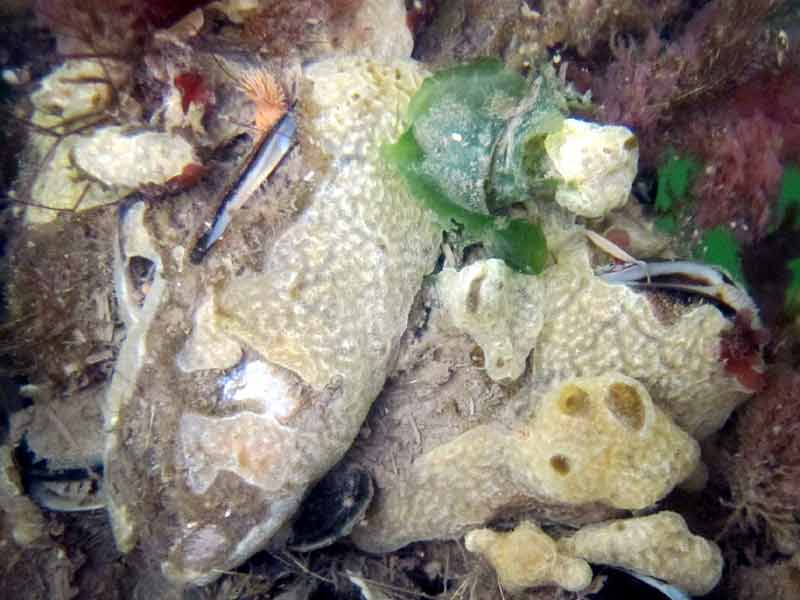The carpet sea squirt (Didemnum vexillum)
Distribution data supplied by the Ocean Biodiversity Information System (OBIS). To interrogate UK data visit the NBN Atlas.Map Help
| Researched by | Eliza Gibson-Hall & Jaret Bilewitch | Refereed by | This information is not refereed |
| Authority | Kott, 2002 | ||
| Other common names | - | Synonyms | Didemnum vestum Kott 2004, Didemnum 'sp. A' |
Summary
Description
Didemnum vexillum is a colonial sea squirt that can form large, leathery patches. The colonies are firm but thin (2-5 mm). The colonies themselves can become quite large owing to the fast growth of the species. It is possible to remove areas of a colony by simply peeling it from the substrata. If Didemnum vexillum grows on vertical or hanging surfaces the colonies can become long and dangling (pendulous) and even detach. The colonies are a single colour, from off-white to cream to a dull orange. Unlike some other colonial sea squirts, Didemnum vexillum lacks black and or/brown markings on its surface. Instead, it has a veiny appearance due to darker water channels within the colony. When contracted, every zooid shows a visible white spot marking the inhalant opening. Large cloacal openings (exit pores) occur at intervals.
Recorded distribution in Britain and Ireland
Recorded from shores near Whitstable and Herne Bay, north Kent. It has been found in marinas and harbours along the south coast from Lymington to Brighton including Southampton and Portsmouth. There are also records from Plymouth and Kingswear in Devon and Burnham-on-Crouch in Essex. In Wales, it has been recorded at Holyhead, and in Scotland it has been found in and around Largs marina and Loch Creran. In Ireland, it has been recorded south along the coast from Strangford Lough to Dublin and in Galway Bay.
Global distribution
Native to Japan. Invasive populations have also been found in Dutch estuaries and along the French north coast. It is also invasive on both coasts of North America and New Zealand.
Habitat
Didemnum vexillum colonizes artificial structures, rocks, boulders and even tide pools. It is usually found in low energy environments where water motion is limited. It is capable of covering extensive areas of the substratum.
Depth range
Shallow - 65 mIdentifying features
- Forms thin, sponge-like, peelable carpets, 2-5 mm thick
- Hanging (pendulous) outgrowths, reaching 1 m long
- Highly flexible, moving with surge or currents
- Colonies a uniform colour of white, cream or dull orange, no dark pigmentation
- Vein-like darker water channels visible within colonies
- Each zooid marked by a white spot when out of water
Additional information
Didemnum vexillum is a non-native species able to survive in a wide range of environments. This has allowed the species to overtake and out-compete native, more vulnerable species. This species is an ALERT invasive species (GBNNSIP, 2018) that can overgrow other species such as other sea squirts or those used in aquaculture such as shellfish. Other species that it is likely to be confused with are: other species of Didemnum, Lissoclinum or Tridemnum spp., and some sponges.
Listed by
- none -
Bibliography
Ames. P., Wade. M., McKee. K., 2012. Didemnid Sea Squirts. NNSS, GB non-native species secretariat. Available: http://www.nonnativespecies.org/index.cfm?sectionid=47
Bowen. S., Goodwin. C., Kipling. D. & Picton. B., 2018. Sea Squirts and Sponges of Britain and Ireland, Seasearch Guide. Plymouth: Wild Nature Press.
GBNNSIP 2018. Carpet sea squirt Didemnum vexillum. Factsheet. [online]. York, GB Nonnative Species Secretariat. Available from: http://www.nonnativespecies.org/factsheet/factsheet.cfm?speciesId=1209 [Accessed: 04/03/2016]
Kott, P., 2002. A complex didemnid ascidian from Whangamata, New Zealand. Journal of the Marine Biological Association of the United Kingdom, 82, 625-628.
Kott, P., 2004. A new species of Didemnum (Ascidiacea, Tunicata) from the Atlantic coast of North America. Zootaxa, 732, 1-10.
Minchin, D. & Sides, E., 2006. Appearance of a cryptogenic tunicate, a Didemnum sp. fouling marina pontoons and leisure craft in Ireland Aquatic Invasions, 1(3), 143-147.
Stefaniuk, L., Lambert, G., Gittenberger, A., Zhang, H., Lin, S. & Whitlach, R.B., 2009. Genetic conspecificity of the worldwide populations of Didemnum vexillum Kott, 2002. Aquatic Invasions, 4(1), 29-44.
Datasets
Centre for Environmental Data and Recording, 2018. Ulster Museum Marine Surveys of Northern Ireland Coastal Waters. Occurrence dataset https://www.nmni.com/CEDaR/CEDaR-Centre-for-Environmental-Data-and-Recording.aspx accessed via NBNAtlas.org on 2018-09-25.
Kent Wildlife Trust, 2018. Kent Wildlife Trust Shoresearch Intertidal Survey 2004 onwards. Occurrence dataset: https://www.kentwildlifetrust.org.uk/ accessed via NBNAtlas.org on 2018-10-01.
NBN (National Biodiversity Network) Atlas. Available from: https://www.nbnatlas.org.
OBIS (Ocean Biodiversity Information System), 2025. Global map of species distribution using gridded data. Available from: Ocean Biogeographic Information System. www.iobis.org. Accessed: 2025-08-08
Citation
This review can be cited as:
Last Updated: 30/10/2018




